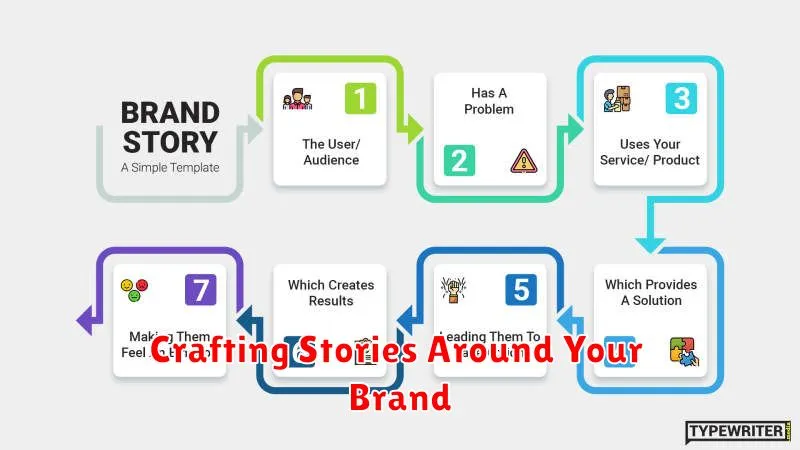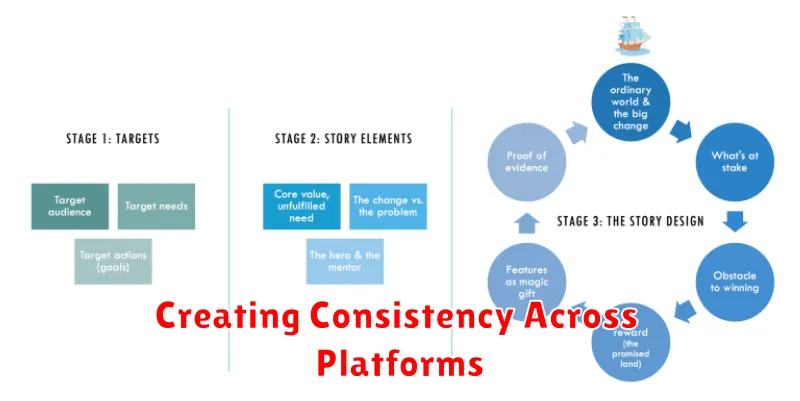In the competitive landscape of modern marketing, cutting through the noise and resonating with your target audience is paramount. Storytelling has emerged as a powerful tool to achieve this, moving beyond traditional advertising and forging genuine connections with consumers. This article delves into the science behind storytelling in marketing, exploring the psychological and neurological principles that underpin its effectiveness. Understanding how narratives impact the human brain allows marketers to craft compelling campaigns that capture attention, build brand loyalty, and ultimately drive conversions. We will explore how storytelling influences consumer behavior, inspiring action and fostering lasting relationships with your brand.
From evoking emotions to enhancing memorability, the science of storytelling provides a framework for optimizing your marketing strategies. By examining the interplay of narrative structure, character development, and emotional triggers, we can unlock the secrets to creating resonant content. This article will provide practical insights and actionable strategies for leveraging the power of storytelling to elevate your marketing efforts, boost engagement, and achieve measurable results. Discover how to tap into the fundamental human desire for connection and meaning through effective storytelling, transforming your marketing from mere promotion to a captivating experience.
Why Storytelling Matters in Marketing
In today’s saturated media landscape, capturing and retaining audience attention is more challenging than ever. Storytelling offers a powerful solution. It moves beyond simply listing product features and benefits, instead creating an emotional connection with consumers. By crafting narratives that resonate with their values, aspirations, and experiences, brands can foster deeper engagement and build lasting relationships. Storytelling makes your brand memorable and helps differentiate it from competitors vying for the same audience.
Effective storytelling in marketing taps into the fundamental human desire for connection and meaning. A compelling narrative can transform a product or service from a simple commodity into a symbol of something larger. Think about how Apple’s marketing doesn’t just focus on technical specifications, but instead emphasizes creativity, innovation, and empowering individuals. This emotional resonance creates a strong sense of brand loyalty and encourages customer advocacy.
Ultimately, storytelling drives measurable results. By forging stronger connections, narratives can influence purchasing decisions, increase brand recognition, and boost customer lifetime value. Stories are also highly shareable, extending brand reach organically through word-of-mouth and social media. In a world dominated by data and algorithms, storytelling brings a vital human element back into the marketing mix, generating tangible returns on investment.
The Psychology of Stories and Emotion
Stories have a profound impact on our emotions. They engage us by tapping into our empathy, allowing us to connect with characters and experience their joys, sorrows, and struggles as if they were our own. This emotional connection is facilitated by the release of neurochemicals like oxytocin, which promotes feelings of connection and trust, and cortisol, which heightens our attention and engagement with the narrative. By experiencing these emotions vicariously through fictional characters, we can process and understand our own feelings more effectively.
The structure of a story also plays a crucial role in its emotional impact. A well-crafted narrative arc, with rising action, a climax, and a resolution, creates anticipation and suspense, keeping us invested in the outcome. Furthermore, the use of literary devices such as foreshadowing, symbolism, and metaphor can deepen our emotional response and create a lasting impression. This structured delivery of emotional content can provide a safe space for exploring complex feelings and developing greater emotional intelligence.
Ultimately, the power of stories lies in their ability to create meaning and offer insight. By exploring universal themes of love, loss, courage, and resilience, stories can help us make sense of the world around us and our own place within it. They provide a framework for understanding the human condition and offer solace, inspiration, and hope in the face of life’s challenges.
Elements of a Strong Marketing Narrative
A compelling marketing narrative goes beyond simply describing a product or service. It connects with the audience on an emotional level, forging a bond that transcends transactional exchange. Authenticity is crucial; the narrative must ring true to the brand’s values and resonate with the target audience’s aspirations and needs. A strong narrative also incorporates conflict, presenting a challenge that the product or service helps overcome. This conflict can be internal, like a personal struggle, or external, like a societal issue.
Clarity and conciseness are essential for effective storytelling. A meandering or convoluted narrative will lose the audience’s attention. The message should be easily understood and memorable. Consistency is also key. The narrative should be woven throughout all marketing materials, from website copy to social media posts, creating a unified and recognizable brand identity.
Finally, a strong marketing narrative must have a clear call to action. What do you want the audience to do after engaging with your story? Whether it’s visiting your website, making a purchase, or joining a community, the desired outcome should be explicitly stated or strongly implied. This ensures that the narrative not only captivates but also converts.
Crafting Stories Around Your Brand

Storytelling is a powerful tool for connecting with your audience on an emotional level. Instead of simply advertising your products or services, crafting narratives around your brand allows you to build authentic relationships. By showcasing your values, mission, and the human element behind your brand, you can create a deeper sense of resonance and loyalty with your customers. Focus on stories that demonstrate how your brand solves problems, helps people overcome challenges, or contributes positively to their lives. This approach fosters a stronger sense of community and belonging around your brand.
Effective brand storytelling requires more than just recounting anecdotes. It’s about carefully crafting a narrative that aligns with your brand identity and resonates with your target audience. Consider your brand’s personality: is it playful, serious, innovative, or traditional? Tailor your stories to reflect these characteristics. Additionally, think about your audience’s needs and aspirations. What kind of stories will resonate with them? What challenges do they face, and how can your brand help them overcome these obstacles? By focusing on the intersection between your brand and your audience, you can create stories that are both engaging and meaningful.
Remember, the goal of brand storytelling is not just to entertain, but to connect. Share stories that are genuine and relatable. Highlight the human element within your brand. Showcase the passion and dedication of your team, the impact your products or services have on real people, and the values that drive your company forward. By letting your audience in, you create a deeper sense of trust and connection, which ultimately strengthens your brand and fosters lasting customer loyalty.
Storytelling in Video vs Text
Video and text offer distinct approaches to storytelling, each with its own strengths. Video excels at conveying emotion and creating immersive experiences through visuals, sound, and motion. It can quickly grab attention and effectively demonstrate complex concepts or processes. However, video production can be resource-intensive, requiring specialized equipment, editing skills, and potentially a larger budget.
Text, on the other hand, allows for greater depth and nuance. Readers can control the pace of consumption and easily revisit specific sections. Text is generally more accessible and less expensive to produce than video. It also lends itself well to in-depth analysis and complex arguments. However, text may struggle to convey the same level of emotional impact as video and can be less engaging for some audiences.
Ultimately, the best medium depends on the specific story, the target audience, and the available resources. A combination of video and text can often be the most effective approach, leveraging the strengths of each medium to create a richer and more engaging storytelling experience.
Real-Life Brand Examples
Strong brands resonate with consumers on an emotional level, creating loyalty and driving sales. Think of companies like Apple, known for its innovative products and sleek design, or Nike, which embodies athletic achievement and inspiration. These brands have cultivated a distinct identity that goes beyond their products or services, fostering a sense of community and belonging among their customers.
Consider a company like Patagonia. Their commitment to environmental sustainability is a core part of their brand identity, attracting customers who share those values. This strong brand positioning not only differentiates them from competitors but also creates a powerful connection with a specific target audience. Similarly, a brand like Dove focuses on real beauty and body positivity, resonating with consumers seeking inclusivity and authenticity in the beauty industry.
These examples demonstrate the power of a well-defined brand. By focusing on core values, creating a unique brand personality, and consistently delivering on their promises, these companies build strong connections with their customers, ultimately fostering long-term loyalty and driving business success.
Measuring Engagement and Impact
Measuring the engagement and impact of initiatives, whether they are marketing campaigns, social programs, or internal communications, requires a thoughtful approach. Key metrics must be identified that align with the specific goals of the initiative. For example, a marketing campaign might focus on website traffic and conversion rates, while a social program might track changes in community health indicators. Data collection methods should be reliable and consistent to ensure accurate measurement. Analyzing data regularly allows for adjustments and optimizations to maximize impact.
Understanding the difference between engagement and impact is crucial. Engagement often represents the level of interaction individuals have with the initiative. This could include metrics like likes, shares, comments, attendance, or participation in activities. Impact, on the other hand, measures the broader effects and outcomes resulting from the initiative. Impact metrics might include increased sales, improved quality of life, or policy changes. It’s important to consider both engagement and impact metrics to get a comprehensive picture of effectiveness.
Choosing the right tools and technologies is essential for effective measurement. A variety of analytics platforms and survey tools are available to track and analyze data. Selecting the appropriate tools depends on the specific metrics being measured and the resources available. Data visualization techniques can help communicate findings clearly and effectively, making it easier for stakeholders to understand the results and make informed decisions.
Avoiding Overused Tropes
Tropes, recurring themes or devices in storytelling, can be effective tools, but when overused, they become predictable and lose their impact. Originality is key to captivating an audience. Consider subverting expectations by twisting a familiar trope or avoiding it altogether. Focus on developing unique characters and compelling plots that resonate with readers on a deeper level.
Common overused tropes include the chosen one narrative, love triangles, and the damsel in distress. While these tropes can be enjoyable in moderation, relying on them heavily can make your writing feel stale and uninspired. Challenge yourself to think outside the box. Explore different narrative structures, create complex character relationships, and develop fresh conflicts that haven’t been explored extensively.
By being mindful of overused tropes and actively seeking creative alternatives, you can elevate your writing and create truly memorable stories. This conscious effort to break free from conventional storytelling devices will allow your unique voice and vision to shine through.
Tools for Visual Storytelling
Visual storytelling involves using visual elements like images, videos, and graphics to convey a narrative. It’s a powerful way to connect with audiences and create a lasting impact. Effective visual storytelling relies on a combination of compelling visuals and a clear, concise message. Choosing the right tools can greatly enhance your ability to craft and share these stories.
Several software options are available depending on your specific needs and budget. For image editing and graphic design, Adobe Photoshop and Illustrator remain industry standards, offering extensive features for manipulating images and creating original artwork. GIMP and Canva provide more accessible, user-friendly alternatives, particularly for beginners or those seeking free options. Video editing software ranges from professional platforms like Adobe Premiere Pro and Final Cut Pro to more accessible options like DaVinci Resolve (free version available) and iMovie. These tools allow you to assemble footage, add music and transitions, and create polished videos.
Beyond software, consider leveraging online platforms designed for visual storytelling. Instagram and Pinterest are excellent choices for sharing image-based narratives, while YouTube and Vimeo are ideal for video content. These platforms provide access to large audiences and offer built-in tools for engagement and community building. Remember that the most effective tool is the one that best suits your particular skills and the story you want to tell. Experiment with different options to find the best fit for your visual storytelling journey.
Creating Consistency Across Platforms

Maintaining a consistent brand experience across different platforms is crucial for building brand recognition and trust. This means ensuring that your visual identity (logo, color palette, typography) and brand voice are consistent whether a customer interacts with your brand on your website, social media, mobile app, or through physical marketing materials. This consistency creates a unified and professional image, strengthening your brand’s overall impact.
Key elements to consider include visual consistency and messaging consistency. Visual consistency involves using the same logo, color scheme, and font styles across all platforms. Messaging consistency involves using a similar tone of voice and ensuring that the core brand message is conveyed clearly regardless of the platform. By paying attention to these details, you can create a seamless and recognizable brand experience.
Consistency builds familiarity and trust with your audience. When customers encounter consistent branding, they are more likely to remember your brand and develop a positive association with it. This ultimately leads to increased brand loyalty and advocacy.

